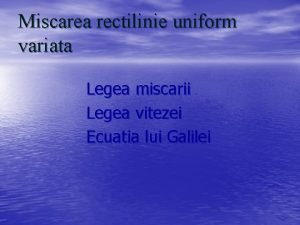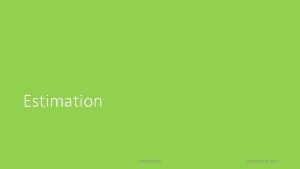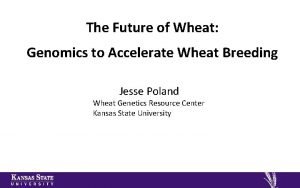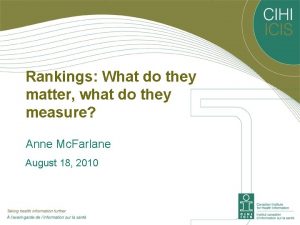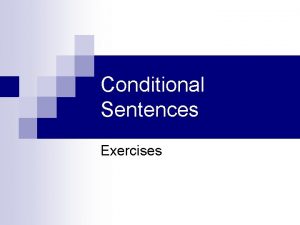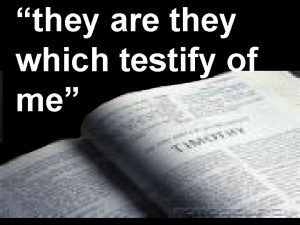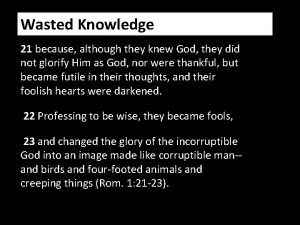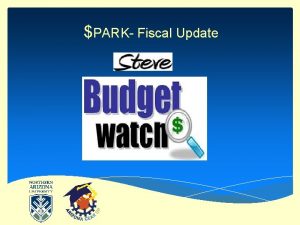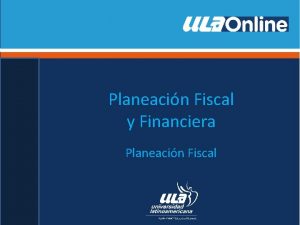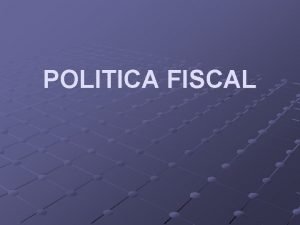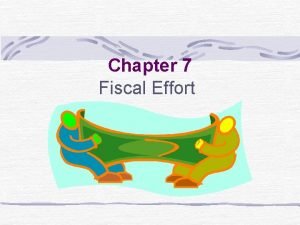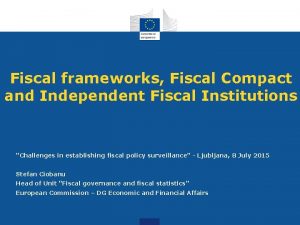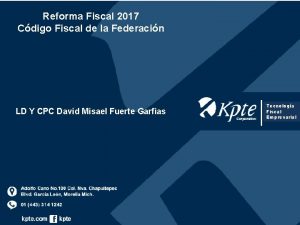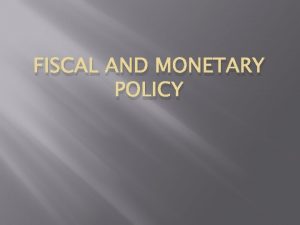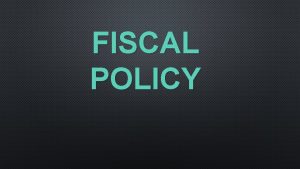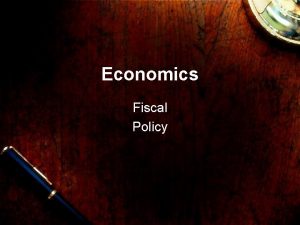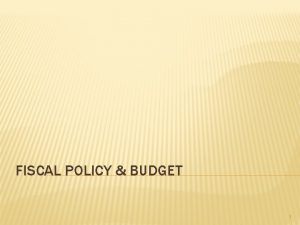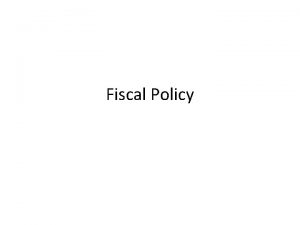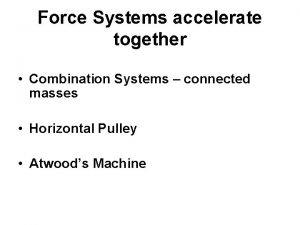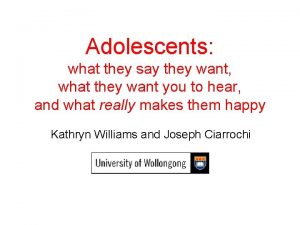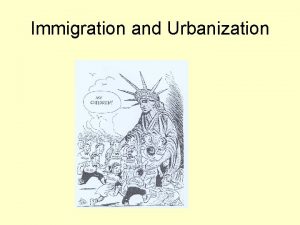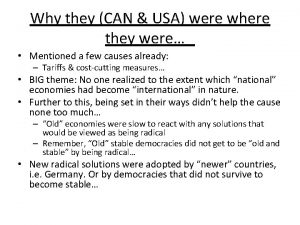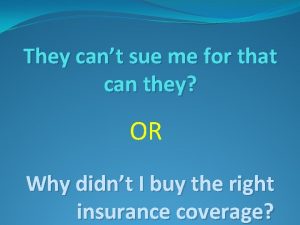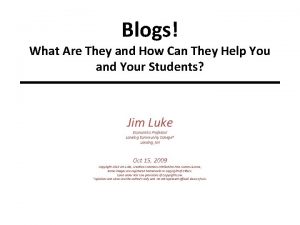WellToWheel Fiscal Systems Can they accelerate the introduction



























































- Slides: 59

Well-To-Wheel Fiscal Systems Can they accelerate the introduction of alternative fuels? www. ecn. nl

Energy research Centre of the Netherlands Petten 2 5 -9 -2021 Amsterdam. Sloterdijk

ECN Policy Studies provides knowledge and strategies that matter for a sustainable energy future • 65 researchers • Backgrounds in a variety Solar energy Biomass Policy Studies • Efficiency & Infrastructure 3 5 -9 -2021 Wind energy of disciplines such as social science, engineering, economics and environmental sciences Addressing energy and climate policy challenges using quantitative tools and qualitative analysis

Content A. INTRODUCTION B. ALTERNATIVE FUELS C. SIDE-EFFECTS D. CONCLUSIONS, QUESTIONS & DISCUSSION 4 5 -9 -2021

DIFVER A. INTRODUCTION 5 5 -9 -2021

A. INTRODUCTION Fiscal policy affects both economy and environment ENV. CHALLENGES POLICY INSTRUMENTS • CO 2 emissions lead to climate change • CO 2 norms • NOx, PM emissions deteriorate air quality 6 5 -9 -2021 • Fuel standards • Mandatory ren. energy share • National obligations & subsidies ‘COMMON GROUND’ NL vehicle and fuel sales, vehicle stock & vehicle use POLICY INSTRUMENTS • Fiscal policy • Rules & regulations for the financial sector ECON. /FIN. CHALLENGES • Budgetary balance • Strong economic structure

A. INTRODUCTION The fiscal system has gradually become ‘greener’, with effect on sales Sales by energy label • Bonus/malus energy labels ‑ 2006 -2009 2007 2008 • CO 2 charge (‘slurptax’) ‑ 2008 -2009 • Exemption BPM/MRB ‑ 2008 -… Source: Ecorys (2011), Fiscale stimulering (zeer) zuinige auto’s 7 5 -9 -2021

A. INTRODUCTION The existing fiscal systems already includes elements that are based on (TTW) emissions Tax base Registration tax (BPM)1), 2) • Fuel type • TTW CO 2 emissions Ownership tax (MRB)3) • Fuel type • Deadweight • TTW CO 2 emissions Excise duty (“accijns”) • Fuel type 1) The replacement of the list price component by the CO 2 based component has been assumed complete. 2) The discount for diesel vehicles emitting less than 5 mg of PM per kilometre 10 has been ignored in this study. 3) In addition, the MRB differs per province. Note: Value-added tax (BTW) applies to vehicle and fuel. It is left unchanged and is therefore omitted here, but is included in all results. 8 5 -9 -2021 This study has investigated how WTW-elements can be introduced

A. INTRODUCTION The relative impact of TTW-emissions is expected to decline in the future WTT-emissions [~15%] Increase expected, due to alternative fuels (e. g. biofuels, electricity) 9 5 -9 -2021 Increase in ratio WTT/TTW expected TTW-emissions [~85%] Decrease expected, due to • more efficient vehicles • alternative fuels

A. INTRODUCTION WTW-elements make ‘the polluter pay’ and prepare the fiscal system for the future Note: Based on the emissions of a new, medium-sized, average efficiency passenger car Only direct emissions have been taken into account! 10 5 -9 -2021

A. INTRODUCTION WTW-elements make ‘the polluter pay’ and prepare the fiscal system for the future The WTT-part of these fuels may increase in the future The use of these fuels will likely increase They are barely taxed, despite the fact they do produce (WTT-)emissions Note: Based on the emissions of a new, medium-sized, average efficiency passenger car Only direct emissions have been taken into account! 11 5 -9 -2021

A. INTRODUCTION Introducing WTW-elements prepares the fiscal system for the future current fuels expected future fuels Note: Based on the emissions of a new, medium-sized, average efficiency passenger car Only direct emissions have been taken into account! 12 5 -9 -2021

A. INTRODUCTION Feasibility fully WTW-based system questionable, two alternatives have been designed Properties of the existing and alternative systems Existing system BPM/MRB • TTW g/km • Fuel specific WTW-elements to be introduced in all taxes • Separate tariffs for all fuels Excise duty 13 5 -9 -2021

A. INTRODUCTION Feasibility fully WTW-based system questionable, two alternatives have been designed Properties of the existing and alternative systems BPM/MRB Excise duty 14 5 -9 -2021 Existing system Alternative 1 • TTW g/km • Fuel specific • WTW g/km • Generic • Separate tariffs for all fuels • Single tariff (g/km WTW) • Based on average over all fuels Difficult to establish actual WTW-emissions Will lead to lower petrol excise duties >> increase in travel demand

A. INTRODUCTION Feasibility fully WTW-based system questionable, two alternatives have been designed Properties of the existing and alternative systems BPM/MRB Excise duty Existing system Alternative 1 Alternative 2 • TTW g/km • Fuel specific • WTW g/km • Generic • TTW g/km • Generic • Separate tariffs for all fuels • Single tariff (g/km WTW) • Based on average over all fuels • Single tariff (g/km WTW) • Based on current petrol tariff ‘Excess’ income compensated by lower BPM & MRB 15 5 -9 -2021

A. INTRODUCTION The proposed changes in the Autobrief influence some of the conclusions in the present study 16 5 -9 -2021

DIFVER B. IMPACT ON ALT. FUELS 17 5 -9 -2021

B. IMPACT ON ALT. FUELS Three groups of alternative fuels have been analysed for an average user GASEOUS FUELS LIQUID BIOFUELS • CNG • Biogas • E 85 • Biodiesel ZERO EMISSION • PHEV* • BEV • FCV * PHEVs are only truly zeroemission vehicles when operated in allelectric mode. • New vehicle • Average efficiency • 15, 000 km/yr 18 5 -9 -2021

B. IMPACT ON ALT. FUELS The graphs on the next slides can be interpreted in the way illustrated below Costs considered in the scope of this study ** ** Fully depreciated over 8 years. 19 5 -9 -2021

DIFVER B. IMPACT ON ALT. FUELS Gaseous fuels 20 5 -9 -2021

B. IMPACT ON ALT. FUELS The position of CNG is better than in the existing system in Alternative 1, similar in Alternative 2 User costs for CNG in the three fiscal systems -15% -22% Low WTW-markup leads to lower taxation -13% Use (additional 7500 km) Use (7500 km) Ownership Purchase 21 5 -9 -2021

B. IMPACT ON ALT. FUELS The position of CNG is better than in the existing system in Alternative 1, similar in Alternative 2 User costs for CNG in the three fiscal systems -15% -22% -13% AUTOBRIEF Use (additional 7500 km) • Higher CNG excise duties, but fuel costs minor share Use (7500 km) Ownership > Competitive position CNG similar to original analysis Purchase 22 5 -9 -2021

B. IMPACT ON ALT. FUELS A minimum share of biofuels is guaranteed by an obligation for fuel distributors > 4. 25% < 95. 75% fuel distributor 23 5 -9 -2021

B. IMPACT ON ALT. FUELS Under the obligation, fuel distributors are required to supply proof of biofuel sold biotickets > 4. 25% biotickets < 95. 75% fuel distributor 24 5 -9 -2021 government

B. IMPACT ON ALT. FUELS Biotickets are tradeable biotickets > 4. 25% € < 95. 75% fuel distributor 25 5 -9 -2021 biotickets fuel distributor

B. IMPACT ON ALT. FUELS Theoretically, the value of a biotickets equals the cost difference between conventional and biofuels biotickets > 4. 25% € < 95. 75% fuel distributor cost/value fuel distributor petrol 26 5 -9 -2021 bioticket E 85 NB: Biotickets only have value up to obligation share!

B. IMPACT ON ALT. FUELS Under the biofuel obligation, CNG and biogas are approx. equally expensive in the alt. systems User costs for CNG and biogas in the three fiscal systems, including biotickets +7% -2% -1% Use (additional 7500 km) Use (7500 km) Ownership Purchase Note: Subsidy for the production of biogas (SDE) has not been taken into account 27 5 -9 -2021

B. IMPACT ON ALT. FUELS Beyond the obligation, biogas is more expensive than CNG in all systems User costs for CNG and biogas in the three fiscal systems, excluding biotickets +18% +9% +10% Use (additional 7500 km) Use (7500 km) Ownership Purchase Note: Subsidy for the production of biogas (SDE) has not been taken into account 28 5 -9 -2021

DIFVER B. IMPACT ON ALT. FUELS Liquid biofuels 29 5 -9 -2021

B. IMPACT ON ALT. FUELS Even beyond the obligation, FFVs are attractive (w. r. t. costs) in the alternative fiscal systems User costs for FFVs in the three fiscal systems +7% -26% -1% Use (additional 7500 km) Use (7500 km) Ownership Purchase 30 5 -9 -2021

B. IMPACT ON ALT. FUELS Even beyond the obligation, biodiesel is attractive (w. r. t. costs) in the alternative fiscal systems User costs for 100% biodiesel in the three fiscal systems +5% -25% -4% Use (additional 7500 km) Use (7500 km) Ownership Purchase 31 5 -9 -2021

DIFVER B. IMPACT ON ALT. FUELS Zero-emission vehicles 32 5 -9 -2021

B. IMPACT ON ALT. FUELS Expected cost reductions will make zero-emission vehicles attractive options in all fiscal systems Expected user costs for zero-emission vehicles in the three fiscal systems in 2020 Use (additional 7500 km) Use (7500 km) Ownership Purchase 33 5 -9 -2021

B. IMPACT ON ALT. FUELS However, efficient conventional vehicles have approximately equal costs Expected user costs for vehicles 40% more efficient than average in the three fiscal systems in 2020 Other fuels/vehicles are also approximately equally expensive 34 5 -9 -2021

B. IMPACT ON ALT. FUELS However, efficient conventional vehicles have approximately equal costs Expected user costs for vehicles 40% more efficient than average in the three fiscal systems in 2020 AUTOBRIEF • Exemption limits are lowered substantially > Incentives for very efficient vehicles decrease > (Relative) attractiveness of alternative fuel vehicles increases 35 5 -9 -2021

DIFVER C. SIDE-EFFECTS & FEASIBILITY 36 5 -9 -2021

C. SIDE-EFFECTS The alternative systems may lead to side-effects and impact on other policy goals Tariff increases Favourable position for diesel vehicles in alt. systems can lead to an increase of the share of diesel vehicles Substantial tariff increases will be required in all systems to keep tax revenue stable Higher MRB older veh. MRB tax burden shifts to older vehicles in alt. systems Travel demand Passenger car travel demand may increase (esp. Alt. 1) Security of supply Impact on security of supply is limited Adm. complexity Both alternative systems are administratively complex Air quality Effects on air quality are uncertain Diesel share increase 37 5 -9 -2021

DIFVER D. CONCLUSIONS 38 5 -9 -2021

D. CONCLUSIONS WTW-based fiscal systems provide a stronger fiscal incentive for some alternative fuels… • WTW-based systems seem to provide a feasible alternative • WTW-based systems stimulate different alternative fuels than the existing system, more in line with ‘polluter pays’ 39 Gaseous fuels Biogas more attractive Liquid biofuels Much stronger incentive for all biofuels Zero-emission Less attractive than in existing system 5 -9 -2021

D. CONCLUSIONS …but come with some side-effects and caveats • A shift to diesel vehicles can be expected in the alternative • systems The incentive for efficient conventional vehicles is about equal to the incentive for alternative fuel vehicles ‑ But Autobrief adjustments will mitigate this issue • The alternative systems… ‑ …may increase passenger car travel (alternative 1) ‑ …are administratively complex ‑ …have uncertain effects for air quality 40 5 -9 -2021

D. CONCLUSIONS The changes announced in the ‘Autobrief’ alter some of the original study conclusions • Many efficient conventional vehicles are no longer tax • • 41 exempt, and are therefore more expensive than BEVs, FCVs, and PHEVs MRB tax burdens for vehicles with relatively low emissions are higher (between the new and old exemption limits) Costs for CNG and flex-fuel vehicles in the alternative systems are higher 5 -9 -2021

DIFVER ADDITIONAL SLIDES 42 5 -9 -2021

BACKUP SLIDES Calculation of WTW-emissions in the context of this study Calculated from: and: JRC, Concawe, EUCAR (2007) - Wellto-Wheels Analysis of Future Automotive Fuels and Powertrains in the European Context ECN/PBL reference projections Derived from: JRC, Concawe, EUCAR (2007) - Well-to-Wheels Analysis of Future Automotive Fuels and Powertrains in the European Context 43 5 -9 -2021

BACKUP SLIDES Tax revenue is kept stable by adjusting tariffs and tax brackets to efficiency improvements 44 5 -9 -2021

BACKUP SLIDES BPM tariff structure in the three fiscal systems Existing system 45 5 -9 -2021 Alternative 2

BACKUP SLIDES MRB tariff structure in the three fiscal systems Existing system 46 5 -9 -2021 Alternative 2

BACKUP SLIDES Excise duties in the three fiscal systems 47 5 -9 -2021

BACKUP SLIDES Fiscal incentives for zero-emission vehicles are strongest in the existing system User costs for zero-emission vehicles in the three fiscal systems Use (additional 7500 km) Use (7500 km) Ownership Purchase 48 5 -9 -2021

BACKUP SLIDES Expected cost reductions will make zero-emission vehicles attractive options in all fiscal systems Expected user costs for zero-emission vehicles in the three fiscal systems in 2020 Use (additional 7500 km) Use (7500 km) Ownership Purchase 49 5 -9 -2021

BACKUP SLIDES Incentive for very efficient vehicles approximately similar to incentive for alternative fuels Expected user costs for vehicles 40% more efficient than average in the three fiscal systems in 2030 50 5 -9 -2021

BACKUP SLIDES More favourable position for diesel vehicles in alt. systems can lead to an increase of diesel share User costs for conventionally fuelled vehicles Currently, ~80% of vehicle stock are petrol vehicles 51 5 -9 -2021

BACKUP SLIDES The alternative systems produce fairer tax burdens with respect to CO 2 emissions Tax burden in relation to CO 2 emissions [g/km] 52 5 -9 -2021

BACKUP SLIDES Substantial tariff increases will be required in all systems to keep tax revenue stable Indexation of tariffs required to keep tax revenue stable (2010 = 100) 53 5 -9 -2021

BACKUP SLIDES Diesel is the cheapest option in the alternative systems, irrespective of annual distance User costs by annual distance for the three fiscal systems Existing system 54 5 -9 -2021 Alternative 2

BACKUP SLIDES Average annual distance of private passenger cars in the Netherlands is 15000 km per year Breakdown NL vehicle stock by annual distance Source: ECN/PBL reference projections 55 5 -9 -2021

BACKUP SLIDES The alternative systems take WTW-emissions of CNG into account Differences in user costs between the three fiscal systems for different production pathways for CNG 56 5 -9 -2021

BACKUP SLIDES The alternative systems take WTW-emissions of E 85 into account Differences in user costs between the three fiscal systems for different production pathways for E 85 57 5 -9 -2021

BACKUP SLIDES The alternative systems take WTW-emissions of biodiesel into account Differences in user costs between the three fiscal systems for different production pathways for biodiesel 58 5 -9 -2021

BACKUP SLIDES The very low MRB exemption limit impacts the MRB structure in the new analysis MRB structure in the original and new (including ‘Autobrief’ changes) analyses 59 5 -9 -2021
 How much work is done on a small car of a 3150
How much work is done on a small car of a 3150 Microsoft partner network cloud essentials
Microsoft partner network cloud essentials Mitacs(dot)ca/en/programs/accelerate/open-projects
Mitacs(dot)ca/en/programs/accelerate/open-projects Accelerate cambridge
Accelerate cambridge Accelerate cvhs
Accelerate cvhs Miscarea rectilinie uniform variata
Miscarea rectilinie uniform variata Pinpoint medicare training
Pinpoint medicare training Accelerate data center modernization
Accelerate data center modernization Accelerate kpi
Accelerate kpi Mathematica
Mathematica Accelerate wheat
Accelerate wheat Rankings: what are they and do they matter?
Rankings: what are they and do they matter? 2. if we sneak out quietly, nobody notice.
2. if we sneak out quietly, nobody notice. We seek him here we seek him there
We seek him here we seek him there Samuel they have rejected me
Samuel they have rejected me They are they which testify of me
They are they which testify of me Grammar rules frustrate me they're not logical they are so
Grammar rules frustrate me they're not logical they are so For they not know what they do
For they not know what they do Knowledge not shared is wasted
Knowledge not shared is wasted Hình ảnh bộ gõ cơ thể búng tay
Hình ảnh bộ gõ cơ thể búng tay Bổ thể
Bổ thể Tỉ lệ cơ thể trẻ em
Tỉ lệ cơ thể trẻ em Gấu đi như thế nào
Gấu đi như thế nào Chụp phim tư thế worms-breton
Chụp phim tư thế worms-breton Chúa yêu trần thế alleluia
Chúa yêu trần thế alleluia Môn thể thao bắt đầu bằng chữ đua
Môn thể thao bắt đầu bằng chữ đua Thế nào là hệ số cao nhất
Thế nào là hệ số cao nhất Các châu lục và đại dương trên thế giới
Các châu lục và đại dương trên thế giới Công thức tính thế năng
Công thức tính thế năng Trời xanh đây là của chúng ta thể thơ
Trời xanh đây là của chúng ta thể thơ Mật thư tọa độ 5x5
Mật thư tọa độ 5x5 Làm thế nào để 102-1=99
Làm thế nào để 102-1=99 Phản ứng thế ankan
Phản ứng thế ankan Các châu lục và đại dương trên thế giới
Các châu lục và đại dương trên thế giới Thơ thất ngôn tứ tuyệt đường luật
Thơ thất ngôn tứ tuyệt đường luật Quá trình desamine hóa có thể tạo ra
Quá trình desamine hóa có thể tạo ra Một số thể thơ truyền thống
Một số thể thơ truyền thống Cái miệng nó xinh thế
Cái miệng nó xinh thế Vẽ hình chiếu vuông góc của vật thể sau
Vẽ hình chiếu vuông góc của vật thể sau Nguyên nhân của sự mỏi cơ sinh 8
Nguyên nhân của sự mỏi cơ sinh 8 đặc điểm cơ thể của người tối cổ
đặc điểm cơ thể của người tối cổ V cc cc
V cc cc Vẽ hình chiếu đứng bằng cạnh của vật thể
Vẽ hình chiếu đứng bằng cạnh của vật thể Fecboak
Fecboak Thẻ vin
Thẻ vin đại từ thay thế
đại từ thay thế điện thế nghỉ
điện thế nghỉ Tư thế ngồi viết
Tư thế ngồi viết Diễn thế sinh thái là
Diễn thế sinh thái là Dot
Dot Số nguyên tố là gì
Số nguyên tố là gì Tư thế ngồi viết
Tư thế ngồi viết Lời thề hippocrates
Lời thề hippocrates Thiếu nhi thế giới liên hoan
Thiếu nhi thế giới liên hoan ưu thế lai là gì
ưu thế lai là gì Hổ đẻ mỗi lứa mấy con
Hổ đẻ mỗi lứa mấy con Sự nuôi và dạy con của hổ
Sự nuôi và dạy con của hổ Hệ hô hấp
Hệ hô hấp Từ ngữ thể hiện lòng nhân hậu
Từ ngữ thể hiện lòng nhân hậu





